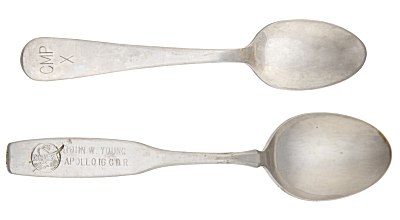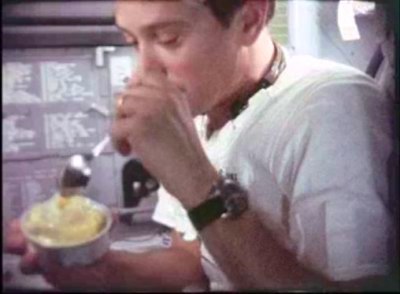Flown cutlery | ||
|
Since NASA's first 'space food' consisted of either rehydrated matter that was squeezed through a tube into the mouth or small 'bite-size' pieces of drier foodstuff that could be eaten directly with the fingers, there was no need for any cutlery to be carried aboard the spacecraft. The crew of Apollo 8 were the first to experiment with using a conventional teaspoon to eat some foods and they found this worked quite well in a weightless environment. The Apollo 9 crew took the experiment one step further by cutting open a rehydratable food package and eating the contents with a spoon. This led to the development of a new kind of food package known as the 'spoon-bowl', first introduced on the Apollo 10 mission. This consisted of a pouch of food that could be rehydrated with hot water, then opened at the top with scissors so that the contents could be eaten with a spoon. Typical 'spoon bowl' meal items included chicken and rice, beef stew, and spaghetti and meat sauce. On later missions some thermostabilised 'wet pack' foodstuffs were provided in a metal container with a peel-off lid and were designed to be eaten directly with a spoon. The Apollo astronauts were usually allowed to keep their personal spoons after the flights and, although mundane-looking, the fact that these spoons were carried into space makes them valuable collectibles. |
||
Apollo missionsThe first spoons to be flown by NASA were apparently carried for experimental purposes on the Apollo 8 and Apollo 9 missions, with one spoon provided per crew member. From Apollo 10 onwards these spoons became part of the regular flight euipment and two additional spoons were provided for use in the Lunar Module. 
Top: Apollo 10 flown Silco spoon The earliest flown spoon I've seen sold dates from Apollo 9. On that mission, and through to Apollo 11, the astronauts used a stainless steel tea spoon produced by Silco - a major supplier of flatware to the military. Each spoon had a simple engraving on the handle with the astronaut's role at the top and the mission number below as a Roman numeral e.g. "CMP / X" for Apollo 10 CMP John Young. From Apollo 12 through to Skylab III the astronauts used a larger Community brand dinner spoon, manufactured by Oneida. A plastic stowage pouch, complete with a small velcro attachment pad, was provided by NASA for each spoon. 
Still frame from Apollo 16 16mm onboard film
showing LMP Charlie For the Apollo missions these Community spoons were engraved with the NASA insignia on the handle followed by the full name of the astronaut. Below the name was engraved either the Apollo flight number and astronaut role (e.g. "APOLLO 16 CDR") or the Lunar Module spacecraft number and astronaut role (e.g. "LM-11 CDR"). The LM spacecraft number was used on the spoons carried in the Lunar Module by the Commander and Lunar Module Pilot, whilst the Apollo mission engraving was used on the Command Module spoons of all three crew members. On Skylab, thanks to the improved food provisions on these long duration missions, astronauts were issued with knives, forks, dessert spoons and teaspoons, all by Community. The engravings on each utensil were simply the role of the crew member e.g. "PLT" with no name. For the Apollo Soyuz Test Project they only carried Community dessert spoons once again. FLOWN availability - Most Apollo and later astronauts were allowed to keep their personal spoons after the mission as mementos and a significant number of these have found their way to market over the years, fetching anywhere from $2,000 to over $10,000, as noted in the Annex below. Unflown availability - It is likely that standard commercially-available spoons were used for training purposes so unflown examples without markings would not be particularly collectible. However, flight-spare examples with NASA markings have appeared on the market from time to time and tend to send well. | ||
|
Annex: Flown cutlery sold at auction or identified in private or museum collections | ||
|
Legal Disclaimer: While every effort is made to ensure that the content of this website is accurate, the website is provided as is and I make no representations or warranties in relation to the accuracy or completeness of the information found on it. Nothing on this website should be taken to constitute professional advice or a formal recommendation and the author excludes all representations and warranties relating to the content and use of this site. In no event shall the author be liable for any incidental, indirect, consequential or special damages of any kind, or any damages whatsoever, including, without limitation, those resulting from loss of profit, goodwill, income, or anticipated savings, whether or not advised of the possibility of such damage, arising out of or in connection with the use of this website or any linked websites. | ||